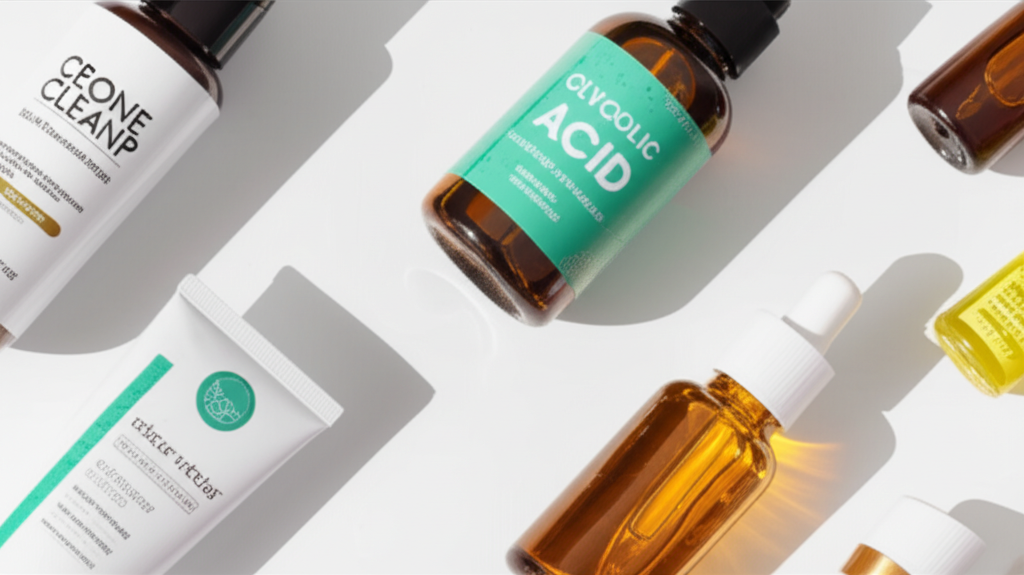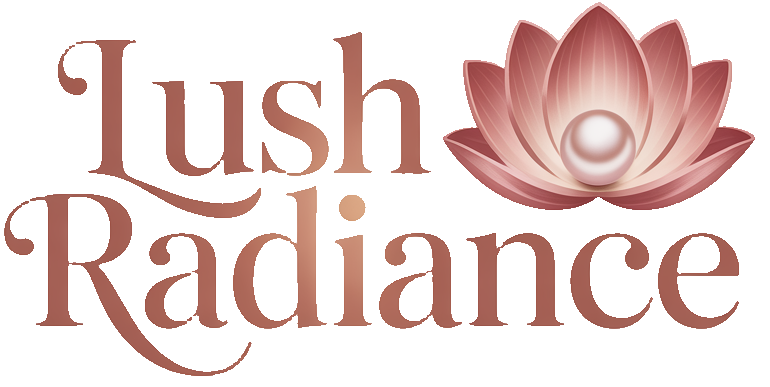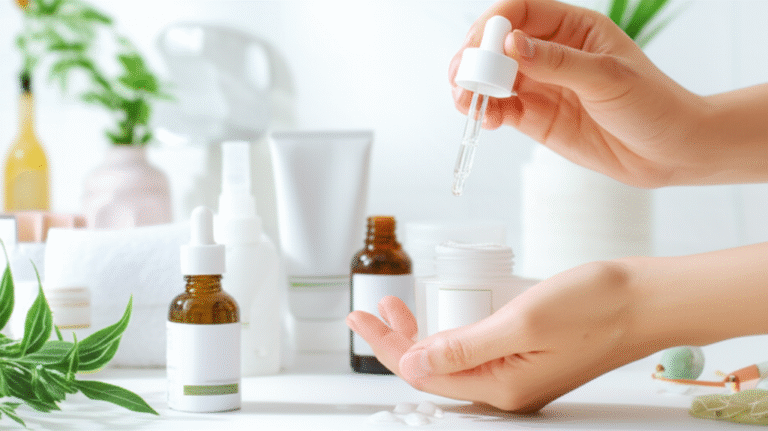Skin Care Products with Glycolic Acid – Unlock radiant skin with glycolic acid! These powerful skin care products gently exfoliate, revealing smoother, brighter, and more even-toned skin. Discover how to use them for proven results and a healthy glow, perfect for beginners seeking effective at-home treatments.
Finding the right skin helpers can feel overwhelming, especially when you see all the ingredients out there. Do you wish your skin looked clearer and felt smoother? Are you tired of dullness or pesky dark spots? Many of us want that healthy, lit-from-within glow, but don’t know where to start. The good news is, you don’t need complicated steps or expensive spa visits. We’re going to dive into one amazing ingredient: glycolic acid. It’s a skincare superstar that’s surprisingly easy to use and delivers beautiful results. Get ready to simplify your routine and reveal your best skin yet!
What Exactly is Glycolic Acid and Why is it a Skincare Hero?

Think of glycolic acid as your skin’s gentle best friend for smoother, brighter days. It’s an alpha-hydroxy acid (AHA) that’s derived from sugarcane. What makes it so special? Its small molecular size allows it to penetrate the skin’s surface effectively.
At a deeper level, glycolic acid works by loosening the bonds between dead skin cells on the surface of your skin. This process, called exfoliation, helps to shed that outer layer of tired, dull skin, making way for fresh, new skin cells underneath. This is why it’s fantastic for improving skin texture, boosting radiance, and tackling various common skin concerns.
The American Academy of Dermatology highlights the role of AHAs like glycolic acid in improving skin tone and texture, making them a valuable tool in a skincare regimen for many individuals.
The Proven Results: What Can Glycolic Acid Do for Your Skin?
Glycolic acid isn’t just hype; it offers tangible improvements you can see and feel. Its ability to exfoliate effectively means it can tackle a range of skin issues, making it a versatile ingredient for many people.
Key Benefits of Using Glycolic Acid
- Brighter Complexion: By removing dead skin cells, glycolic acid helps reveal the fresh, radiant skin underneath, combating dullness.
- Smoother Texture: It helps to smooth rough patches and improve the overall feel of your skin.
- Evens Skin Tone: It can visibly reduce the appearance of dark spots, hyperpigmentation, and minor acne scars, leading to a more uniform complexion.
- Minimizes Fine Lines: Regular use can help soften the appearance of fine lines and wrinkles by promoting cell turnover.
- Helps Unclog Pores: Its exfoliating action can help prevent pores from becoming blocked, reducing breakouts and improving skin clarity.
- Boosts Hydration: While it exfoliates, it also helps skin retain moisture better by removing the barrier of dead cells.
Understanding Glycolic Acid Concentrations: What’s Right for You?
Just like choosing the right strength of something, picking a glycolic acid product depends on your skin type and what you want to achieve. Products come in different strengths, usually measured by percentage. Starting low is always the smartest approach, especially for beginners.

Glycolic Acid Concentration Guide
| Concentration Range | Who It’s For | Typical Product Type | Frequency of Use | Key Benefits |
|---|---|---|---|---|
| 1-5% | Beginners, sensitive skin, daily maintainance | Cleansers, toners, moisturizers | Daily or every other day | Gentle exfoliation, mild brightening, improved hydration |
| 5-10% | Most skin types, noticeable texture/tone improvement | Toners, serums, stronger exfoliants | 2-3 times per week | Moderate exfoliation, visible brightness, pore refinement |
| 10%+ | Resilient skin, those targeting significant concerns (hyperpigmentation, acne scars), under professional guidance | Peel treatments, targeted serums | 1-2 times per week (or directed by professional) | Strong exfoliation, dramatic texture change, reduction of persistent dark spots |
For those just starting out with glycolic acid, it’s best to begin with products that contain a lower concentration, like 4% or 5%. You can gradually increase the concentration as your skin becomes accustomed to it and if you feel you need more. Always patch-test a new product on a small area of your skin before applying it to your entire face.

The Ordinary Favorites Collection For Luminous, Hydrated Skin
Skin Care Bundle Set – Glycolic Acid 7% Exfoliating Toner, Hyaluronic Acid 2% + B5, Natural Moisturizing Factors + HA
- Brand: The Ordinary
- Bundle Price: $36.90
- Includes: Glycolic Acid 7% Exfoliating Toner 8.1 Fl Oz, Hyaluronic Acid 2% + B5 1 Fl Oz, Natural Moisturizing Factors + HA 3.4 Fl Oz
- Suggested Use: Use Hyaluronic Acid in the morning & evening, Glycolic Acid Toner in the evening, and Natural Moisturizing Factors twice daily
- Skin Type: All
- Benefits: Exfoliating, Hydrating, Moisturizing, Luminous Skin
How to Incorporate Glycolic Acid Products into Your Routine: A Beginner’s Guide
Adding glycolic acid to your skincare routine is simple when you follow a few basic rules. The key is to start slowly and pay attention to how your skin reacts.
Step-by-Step Integration
- Start Slow: Begin by using your chosen glycolic acid product 1-2 times per week, preferably in the evening. This gives your skin time to adjust without overwhelming it.
- Cleanse First: Always start with a clean face. Use a gentle cleanser to remove makeup, dirt, and oil before applying your glycolic acid treatment.
- Apply Your Treatment: Follow the specific product instructions. If it’s a serum or toner, apply a thin layer to your face, avoiding the immediate eye area. If it’s a wash-off product, follow the time recommendations.
- Follow Up with Moisturizer: Glycolic acid can be drying for some. Apply a hydrating, yet non-comedogenic (won’t clog pores) moisturizer afterward to lock in hydration and soothe your skin.
- Observe Your Skin: Pay attention. Expect a slight tingling sensation, but stinging or redness means you should reduce frequency or use a lower concentration.
- Increase Gradually: As your skin tolerates the product, you can slowly increase the frequency to every other night, or even nightly if your skin is not sensitive.
Evening is Best
While some low-concentration glycolic acid products can be used in the morning, especially in a cleanser or moisturizer, it’s generally recommended to use exfoliating treatments like serums or toners with glycolic acid in the evening. This allows your skin to work its magic overnight without the risk of sun sensitivity from the day.
Choosing the Right Glycolic Acid Product for Your Needs
With so many options, how do you pick the best skin care products with glycolic acid? Consider your skin type, your primary concerns, and the product’s overall formulation.
Types of Glycolic Acid Products
- Cleansers: Gentle for daily use or a couple of times a week. Great for a light exfoliation boost while cleansing.
- Toners: Applied after cleansing, before serums. Excellent for prepping skin and providing a dose of AHA.
- Serums: Concentrated treatments for targeted concerns. Usually used after toner and before moisturizer.
- Moisturizers: Combine hydration with mild exfoliation. Ideal for those wanting a simpler routine.
- Peels/Masks: More intensive treatments, often with higher concentrations. Use less frequently.
Product Recommendations for Beginners
When you’re starting, look for products labeled as “gentle,” “for sensitive skin,” or those with lower glycolic acid percentages (under 5%).
- The Ordinary Glycolic Acid 7% Toning Solution: A popular and affordable option for moderate exfoliation. Use it a few times a week as a toner.
- Paula’s Choice SKIN PERFECTING 8% AHA Lotion Exfoliant: This contains glycolic acid plus other beneficial ingredients to smooth and hydrate. It’s a leave-on exfoliant that can be used a few times a week.
- CeraVe Skin Renewing Gel Oil: While not solely glycolic acid, it contains a blend of AHAs and ceramides, offering a more balanced approach to exfoliation and skin barrier support. Can be used most nights.
Always read product reviews and check ingredients lists for other components that might suit your skin.
Essential Tips for Success and Avoiding Irritation
Using glycolic acid is rewarding, but a little caution goes a long way. Here’s how to maximize benefits and keep your skin happy.
Golden Rules for Using Glycolic Acid
- Sunscreen is Non-Negotiable: Glycolic acid makes your skin more sensitive to the sun. Apply a broad-spectrum SPF 30 or higher every single day, even if it’s cloudy or you’re mostly indoors. Reapply as needed. The Skin Cancer Foundation emphasizes the importance of daily SPF use to protect against UV damage.
- Don’t Overdo It: Resist the temptation to use it more often than recommended. Over-exfoliation can lead to redness, irritation, and a compromised skin barrier.
- Introduce One New Active at a Time: If you’re also using other strong active ingredients like retinoids or vitamin C, introduce them gradually and space them out on different nights to avoid overwhelming your skin.
- Listen to Your Skin: If you experience significant redness, peeling, or irritation, take a break from the glycolic acid for a few days and then reintroduce it at a lower frequency or concentration.
- Hydrate, Hydrate, Hydrate: Always follow up with a good moisturizer to keep your skin barrier healthy and prevent dryness.
- Be Patient: Visible results take time. Stick with your routine consistently for several weeks to truly see the benefits unfold.
When to Talk to a Dermatologist
While glycolic acid is generally safe and effective for many, there are times when professional advice is best.
Signs You Might Need to Consult a Pro
- Severe Redness or Burning: If you experience intense burning, redness that doesn’t subside, or significant peeling, it’s time to see a dermatologist.
- Persistent Irritation: If your skin remains irritated despite adjusting the product or frequency, a professional can help diagnose underlying issues.
- Underlying Skin Conditions: If you have conditions like eczema, rosacea, or active acne, consult your dermatologist before starting any new active treatments like glycolic acid.
- Targeting Deep Concerns: For severe hyperpigmentation, deep acne scars, or significant anti-aging goals, a dermatologist can offer prescription-strength treatments or professional procedures.
- Unsure About Product Choice: If you’re overwhelmed by product choices or unsure which concentration is right for your specific skin type and concerns, a dermatologist can provide personalized recommendations.
A board-certified dermatologist, like those recognized by the American Academy of Dermatology, can provide expert guidance tailored to your unique skin needs.
Frequently Asked Questions About Glycolic Acid Products
- What is the best time of day to use glycolic acid?
- It’s generally best to use glycolic acid products in the evening. This allows your skin to exfoliate and repair overnight without the added risk of sun sensitivity during the day.
- How often should I use glycolic acid?
- As a beginner, start with 1-2 times per week. As your skin tolerates it, you can gradually increase to every other night or nightly, depending on the product concentration and your skin’s reaction. Always follow product instructions and listen to your skin.
- Can I use glycolic acid with other active ingredients?
- You can, but do so cautiously. Avoid using glycolic acid on the same night as other strong exfoliants or retinoids until your skin is accustomed to both. Consider using them on alternating nights. Vitamin C can often be used in the morning, with glycolic acid at night, but monitor your skin’s response.
- Will glycolic acid make my skin peel?
- Some minimal peeling or flaking can occur, especially when you first start or use higher concentrations. However, excessive peeling is a sign of over-exfoliation and you should reduce the frequency or intensity of use.
- Is glycolic acid suitable for all skin types?
- Glycolic acid can be effective for many skin types, but those with very sensitive skin or conditions like rosacea or eczema should start with very low concentrations (1-3%) or consult a dermatologist first. It’s crucial to patch-test and introduce it slowly.
- How long does it take to see results from glycolic acid?
- You might notice a difference in your skin’s brightness and smoothness within a few uses. However, significant improvements in texture, tone, and fine lines usually become apparent with consistent use over 4-6 weeks or longer.
- Can I use glycolic acid on acne?
- Yes, glycolic acid can be very helpful for acne! By exfoliating dead skin cells, it can help prevent pores from becoming clogged, which is a primary cause of acne. It also helps improve the appearance of acne scars.
Conclusion: Embrace Your Glow with Glycolic Acid!
Incorporating glycolic acid into your skincare routine is a fantastic step towards achieving that smooth, bright, and even-toned complexion you desire. Whether you’re tackling dullness, uneven texture, or the early signs of aging, this AHAs’ proven results make it a skincare hero for a reason. Remember the golden rules: start slow, always use sunscreen, hydrate generously, and listen to your skin. With a little patience and consistency, you’ll soon discover the beautiful, glowing skin that glycolic acid can help reveal. Happy glowing!



